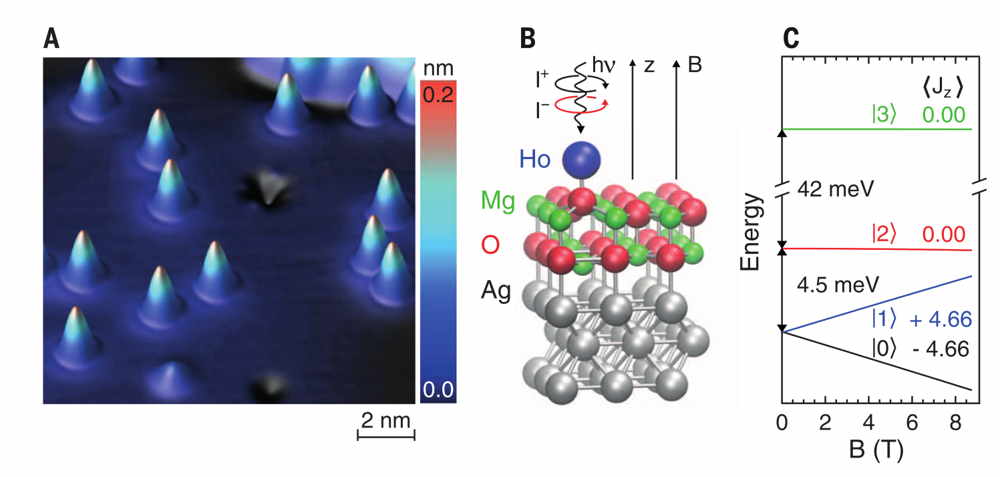R&D: Single-Atom Magnet Breaks New Ground for Future Storage
Paves way for scalable production of miniature magnetic storage devices.
By Francis Pelletier | April 20, 2016 at 2:53 pmFrom Ecole Polytechnique Fédérale de Lausanne, Switzerland.
Scientists at EPFL (Ecole Polytechnique Fédérale de Lausanne) and ETH Zürich (Eidgenössische Technische Hochschule Zürich) have built a single-atom magnet that is the most stable to-date. The breakthrough paves the way for the scalable production of miniature magnetic storage devices.
Magnetic storage devices such as computer hard drives or memory cards are widespread today. But as computer technology grows smaller, there is a need to also miniaturize data storage. This is epitomized by an effort to build magnets the size of a single atom. However, a magnet that small is very hard to keep ‘magnetized’, which means that it would be unable to retain information for a meaningful amount time. In a breakthrough study published in Science, researchers led by EPFL and ETH Zurich have now built a single-atom magnet that, although working at around 40 Kelvin (-233.15oC), is the smallest and most stable to date.
Fig. 1. Ho atoms on MgO films.
(A) Constantcurrent STM image of Ho atoms
on 2 monolayer (ML) MgO/Ag(100) (tunnel voltage Vt = 100 mV,
tunnel current It = 20 pA, T = 4.7 K, Ho coverage QHo = 0.005 ± 0.001 ML).
(B) Adsorption geometry of Ho atoms on top of O on 2-ML MgO/Ag(100) as simulated
with DFT, together with a schematic of the XAS experiment. (
C) Splitting of the lowest quantum levels of Ho atoms from multiplet
calculations.Zero-field values of hJzi are reported.
(Click to enlarge)
Magnets work because of electron spin, which is a complicated motion best imagined as a spinning top. Electrons can spin up or down (something like clockwise or anti-clockwise), which creates a tiny magnetic field. In an atom, electrons usually come in pairs with opposite spins, thus cancelling out each other’s magnetic field. But in a magnet, atoms have unpaired electrons, and their spins create an overall magnetic field.
A challenge today is to build smaller and smaller magnets that can be implemented in data storage devices. The problem is something called ‘magnetic remanence’, which describes the ability of a magnet to remain magnetized. Remanence is very difficult to observe from a single atom, because environmental fluctuations can flip its magnetic fields. In terms of technology, a limited remanence would mean limited information storage for atom-sized magnets.
A team of scientists led by Harald Brune at EPFL and Pietro Gambardella at ETH Zurich, have built a prototypical single-atom magnet based on atoms of the rare-earth element holmium. The researchers, placed single holmium atoms on ultrathin films of magnesium oxide, which were previously grown on a surface of silver. This method allows the formation of single-atom magnets with robust remanence. The reason is that the electron structure of holmium atoms protects the magnetic field from being flipped.
The magnetic remanence of the holmium atoms is stable at temperatures around 40 Kelvin (-233.15oC), which, though far from room temperature, are the highest achieved ever. The scientists’ calculations demonstrate that the remanence of single holmium atoms at these temperatures is much higher than the remanence seen in previous magnets, which were also made up of 3-12 atoms. This makes the new single-atom magnet a worldwide record in terms of both size and stability.
This project involved a collaboration of EPFL’s Institute of Condensed Matter Physics with ETH Zurich, Swiss Light Source (PSI), Vinča Institute of Nuclear Sciences (Belgrade), the Texas A&M University at Qatar and the European Synchrotron Radiation Facility (Grenoble). It was funded by the Swiss National Science Foundation, the Swiss Competence Centre for Materials Science and Technology (CCMX), the ETH Zurich, EPFL and the Marie Curie Institute, and the Serbian Ministry of Education and Science.
Science Magazine has published an article written by F. Donati, S. Rusponi, Institute of Physics, Ecole Polytechnique Fédérale de Lausanne (EPFL), Station 3, CH-1015 Lausanne, Switzerland, S. Stepanow, Department of Materials, ETH Zürich, Hönggerbergring 64, CH-8093 Zürich, Switzerland, C. Wäckerlin, A. Singha, Institute of Physics, Ecole Polytechnique Fédérale de Lausanne (EPFL), Station 3, CH-1015 Lausanne, Switzerland, L. Persichetti, Department of Materials, ETH Zürich, Hönggerbergring 64, CH-8093 Zürich, Switzerland, R. Baltic, K. Diller, F. Patthey, E. Fernandes, Institute of Physics, Ecole Polytechnique Fédérale de Lausanne (EPFL), Station 3, CH-1015 Lausanne, Switzerland, J. Dreiser, Institute of Physics, Ecole Polytechnique Fédérale de Lausanne (EPFL), Station 3, CH-1015 Lausanne, Switzerland, and Swiss Light Source, Paul Scherrer Institute, CH-5232 Villigen PSI, Switzerland, Ž. Šljivancanin, Vinca Institute of Nuclear Sciences (020), Post Office Box 522, 11001 Belgrade, Serbia, and Texas A&M University at Qatar, Doha, Qatar, K. Kummer, European Synchrotron Radiation Facility (ESRF), F-38043 Grenoble, France, C. Nistor, P. Gambardella, Department of Materials, ETH Zürich, Hönggerbergring 64, CH-8093 Zürich, Switzerland, and H. Brune, Institute of Physics, Ecole Polytechnique Fédérale de Lausanne (EPFL), Station 3, CH-1015 Lausanne, Switzerland.
Abstract: “A permanent magnet retains a substantial fraction of its saturation magnetization in the absence of an external magnetic field. Realizing magnetic remanence in a single atom allows for storing and processing information in the smallest unit of matter. We show that individual holmium (Ho) atoms adsorbed on ultrathin MgO(100) layers on Ag(100) exhibit magnetic remanence up to a temperature of 30 kelvin and a relaxation time of 1,500 seconds at 10 kelvin. This extraordinary stability is achieved by the realization of a symmetry-protected magnetic ground state and by decoupling the Ho spin from the underlying metal by a tunnel barrier.“














 Subscribe to our free daily newsletter
Subscribe to our free daily newsletter
